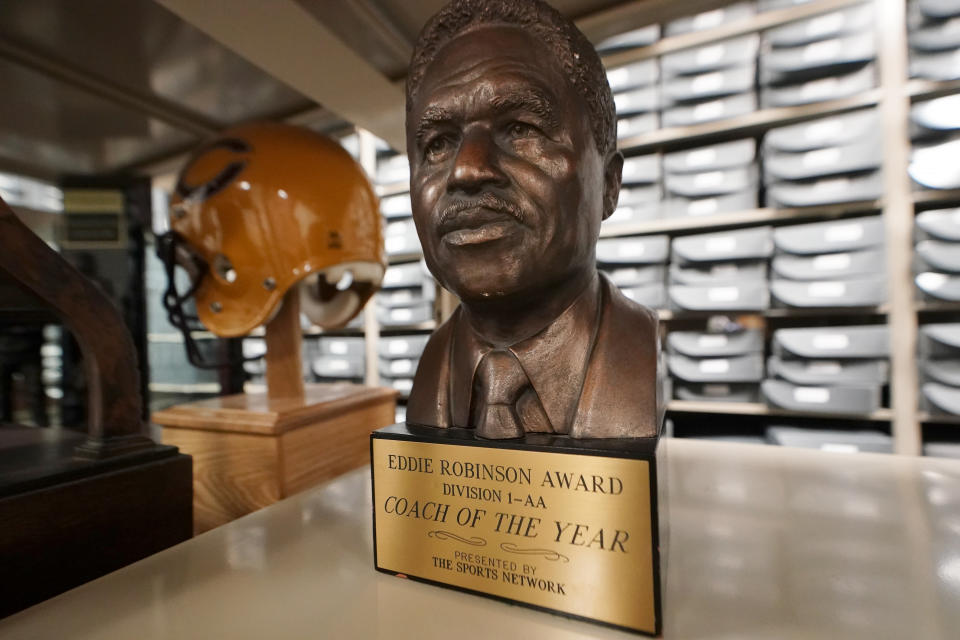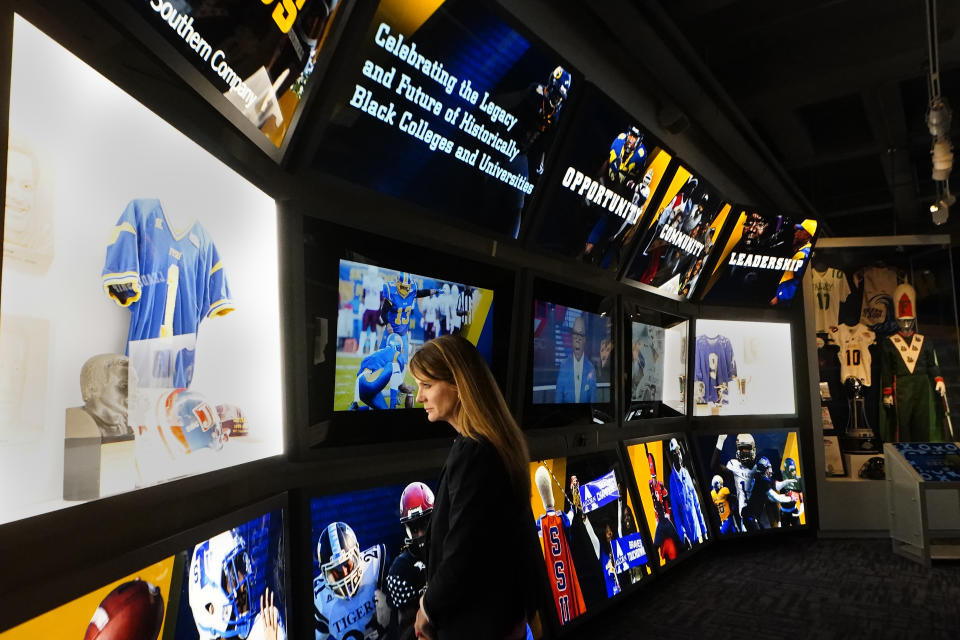Column: A tribute to the trailblazers of college football
ATLANTA (AP) — When racial protests rocked the nation last summer, the College Football Hall of Fame became a target of the anger.
The glass facade that looks out over Centennial Olympic Park was shattered. The gift shop was vandalized. The final toll was a quarter-million dollars in damage.
Fortunately, nothing of real value was harmed. Even better, those who run this shrine to the gridiron in downtown Atlanta realized that a change in priorities was needed.
Before the protests, they had been planning a tribute to Southern football -- which, for all the towering figures and glorious exploits, is still tinged with the stain of segregation.
”In light of everything that had gone on, Southern football didn’t seem like the right thing to do,” said Kimberly Beaudin, the hall’s chief executive officer.
Instead, curator Jeremy Swick quickly assembled an expanded tribute to Historically Black Colleges and Universities, better known as HBCUs.
That's where many of the forgotten stars of Southern football played the game, chipping away at the barriers face by people of color.
“There was a lot of courageous change that happened,” Beaudin said. “That courage is what we need today."
Speaking of courage, the Georgia Bulldogs will be honoring a group of their most influential players Saturday during a game against South Carolina.
Richard Appleby, Horace King, Chuck Kinnebrew, Clarence Pope and Larry West were the first Black players to receive scholarships to play football between the hedges — hallowed turf that had long been the domain of white players only.
“The First Five” made their debut on the freshman team a mere 50 years ago. A blip in time, when you really think about it.
“It certainly sounds like a long time,” West said, “but it seems like it was just yesterday.”
While the vast majority of our attention is focused on where the game is headed -- from jarring conference realignments to Nick Saban trying to win another national title to players finally being able to earn a buck or two off their names and likenesses -- we shouldn't forget those who laid the groundwork not so long ago.
Thankfully, the racial reawakening that emerged from the long, hot summer of 2020 sparked a renewed interest in the enormous role that HBCUs played in the developing the modern college game, with increased media coverage spurred along by the arrival of prominent coaches such as Deion Sanders at Jackson State and Eddie George at Tennessee State.
The HBCUs are suddenly hip, at least to a very large segment of white America that was blissfully unaware of the amazing stories these schools could tell.
Black America has every right to wonder: What took you so long?
At the College Football Hall of Fame, they’re hoping folks will linger for a while at their new exhibit, which better late than never celebrates the opportunity, community and leadership that HBCUs brought to so many lives when the scourge of racism closed so many doors.
“We're here to entertain people, but we're also here to educate and inspire," Beaudin said. "That's an important part of our mission. If they learn something they didn't know and have a deeper understanding of the value of HBCUs, that is invaluable.”
The display honors the coaches, players and teams that any true college football fan should know, such as Grambling’s Eddie Robinson, but just as compelling are those that have largely faded from memory.
For instance, there’s a banner from Maryland Eastern Shore, formerly known as Maryland State, an HBCU that is likely the greatest college football program you never heard of.
For roughly a quarter century stretching from the end of the World War II to the demise of segregation, the Hawks produced multiple undefeated seasons, numerous conference championships and an array of stellar players, including Emerson Boozer and Art Shell.
Sadly, football at Maryland Eastern Shore went the way of the Negro Leagues, shutting down more than four decades ago after integration provided more prominent options to players such as the Georgia Five.
Growing up in segregated Athens, King figured he would have to play his college ball at an HBCU.
But times were a-changing in the late 1960s and early '70s. Four years after Nate Northington became the first Black scholarship football player in the SEC in 1967, Georgia coach Vince Dooley was knocking at the door, offering King a scholarship to play at Sanford Stadium for the mighty Bulldogs.
There were challenges, of course. Those who favored the status quo greeted the First Five with Confederate flags and nooses.
Even so, they generally look back fondly on their time in Athens, heaping praise on everyone from the coaches who kept them in line to the cafeteria workers who kept their bellies full.
They were just teenagers when they arrived on campus, but they were very much aware of the impact they could make.
Failure was not an option.
“We never talked about it not working," Kinnebrew said. "We talked about what it would take for us to improve it so we could pave the way for other guys to come.”
They did their job well.
Just nine years later, a dynamic Black running back from tiny Wrightsville, Georgia, a fellow by the name of Herschel Walker, would lead the red and black to a perfect record and what remains their only consensus national championship.
On Saturday, the Georgie Five will be at Sanford Stadium to cheer on a Bulldogs team that is ranked No. 2 in the nation and led largely by Black players.
All of it made possible by the First Five, whose influence would stretch far beyond the gridiron, to the lives they've all led since that momentous fall five decades ago.
“I'm grateful that we've been able to show that we were more than just football players,” West said. "We were human beings who set goals and objectives, had ambitions.
“I believe," he added, "we were the right five at the right time to do the things that have been done and to make tremendous contributions to the society in which we live.”
There is still much work to be done, of course.
There aren't nearly enough Black head coaches and administrators and college presidents.
“Progress is being made. It is slow,” King acknowledged. “Nothing is ever fast enough.”
But for all that has changed, we owe a huge debt to HBCUs such as Maryland Eastern Shore and brave players such as the Georgia's First Five.
We can never repay them.
The least we can do is never forget them.
___
Paul Newberry is a national sports columnist for The Associated Press. Write to him at pnewberry(at)ap.org or at https://twitter.com/pnewberry1963 and check out his work at https://apnews.com/search/paulnewberry
___
More AP college football: https://apnews.com/hub/college-football and https://twitter.com/AP_Top25. Sign up for the AP’s college football newsletter: https://apnews.com/cfbtop25



